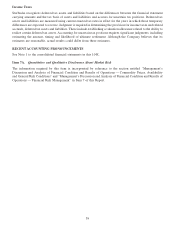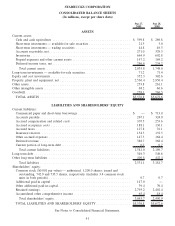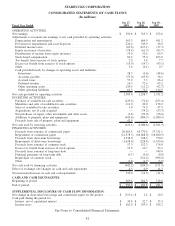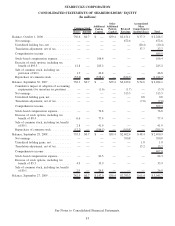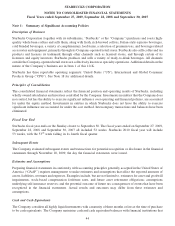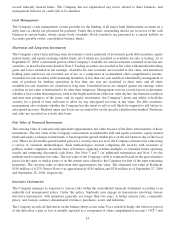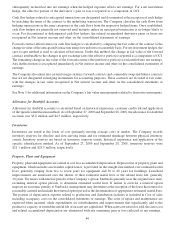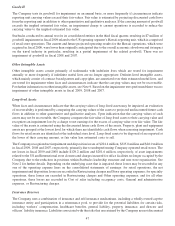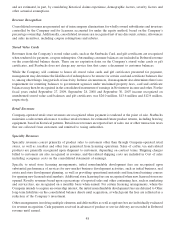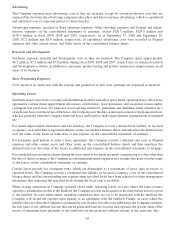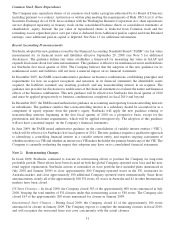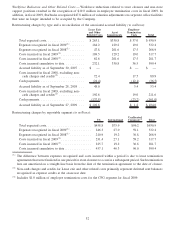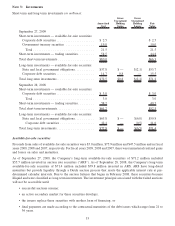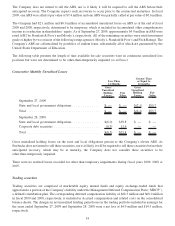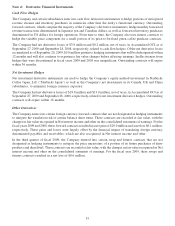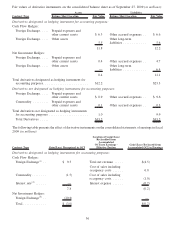Starbucks 2009 Annual Report Download - page 57
Download and view the complete annual report
Please find page 57 of the 2009 Starbucks annual report below. You can navigate through the pages in the report by either clicking on the pages listed below, or by using the keyword search tool below to find specific information within the annual report.Advertising
The Company expenses most advertising costs as they are incurred, except for certain production costs that are
expensed the first time the advertising campaign takes place and direct-response advertising, which is capitalized
and amortized over its expected period of future benefits.
Advertising expenses, recorded in Store operating expenses, Other operating expenses and General and admin-
istrative expenses on the consolidated statements of earnings, totaled $126.3 million, $129.0 million and
$103.5 million in fiscal 2009, 2008 and 2007, respectively. As of September 27, 2009 and September 28,
2008, $7.2 million and $8.8 million, respectively, of capitalized advertising costs were recorded in Prepaid
expenses and other current assets, and Other assets on the consolidated balance sheets.
Research and Development
Starbucks expenses research and development costs as they are incurred. The Company spent approximately
$6.5 million, $7.2 million and $7.0 million during fiscal 2009, 2008 and 2007, respectively, on technical research
and development activities, in addition to customary product testing and product and process improvements in all
areas of its business.
Store Preopening Expenses
Costs incurred in connection with the start-up and promotion of new store openings are expensed as incurred.
Operating Leases
Starbucks leases retail stores, roasting and distribution facilities and office space under operating leases. Most lease
agreements contain tenant improvement allowances, rent holidays, lease premiums, rent escalation clauses and/or
contingent rent provisions. For purposes of recognizing incentives, premiums and minimum rental expenses on a
straight-line basis over the terms of the leases, the Companyuses the date of initial possession to begin amortization,
which is generally when the Company enters the space and begins to make improvements in preparation of intended
use.
For tenant improvement allowances and rent holidays, the Company records a deferred rent liability in Accrued
occupancy costs and Other long-term liabilities on the consolidated balance sheets and amortizes the deferred rent
over the terms of the leases as reductions to rent expense on the consolidated statements of earnings.
For premiums paid upfront to enter a lease agreement, the Company records a deferred rent asset in Prepaid
expenses and other current assets and Other assets on the consolidated balance sheets and then amortizes the
deferred rent over the terms of the leases as additional rent expense on the consolidated statements of earnings.
For scheduled rent escalation clauses during the lease terms or for rental payments commencing at a date other than
the date of initial occupancy, the Company records minimum rental expenses on a straight-line basis over the terms
of the leases on the consolidated statements of earnings.
Certain leases provide for contingent rents, which are determined as a percentage of gross sales in excess of
specified levels. The Company records a contingent rent liability in Accrued occupancy costs on the consolidated
balance sheets and the corresponding rent expense when specified levels have been achieved or when management
determines that achieving the specified levels during the fiscal year is probable.
When ceasing operations in Company-operated stores under operating leases, in cases where the lease contract
specifies a termination fee due to the landlord, the Company records such expense at the time written notice is given
to the landlord. In cases where terms, including termination fees, are yet to be negotiated with the landlord, the
Company will record the expense upon signing of an agreement with the landlord. Finally, in cases where the
landlord does not allow the Company to prematurely exit its lease, but allows for subleasing, the Company estimates
the fair value of any sublease income that can be generated from the location and expenses the present value of the
excess of remaining lease payments to the landlord over the projected sublease income at the cease-use date.
49


